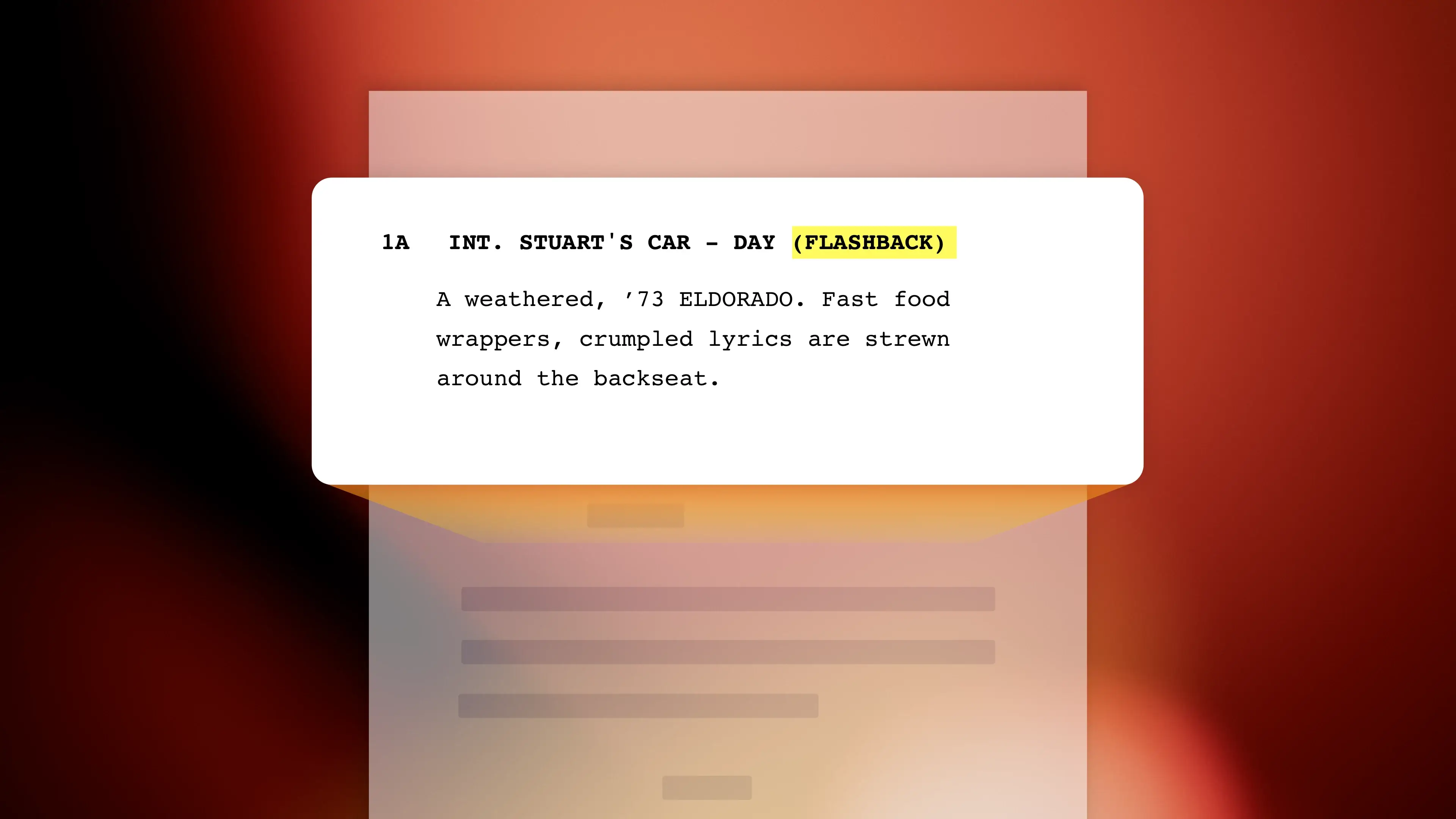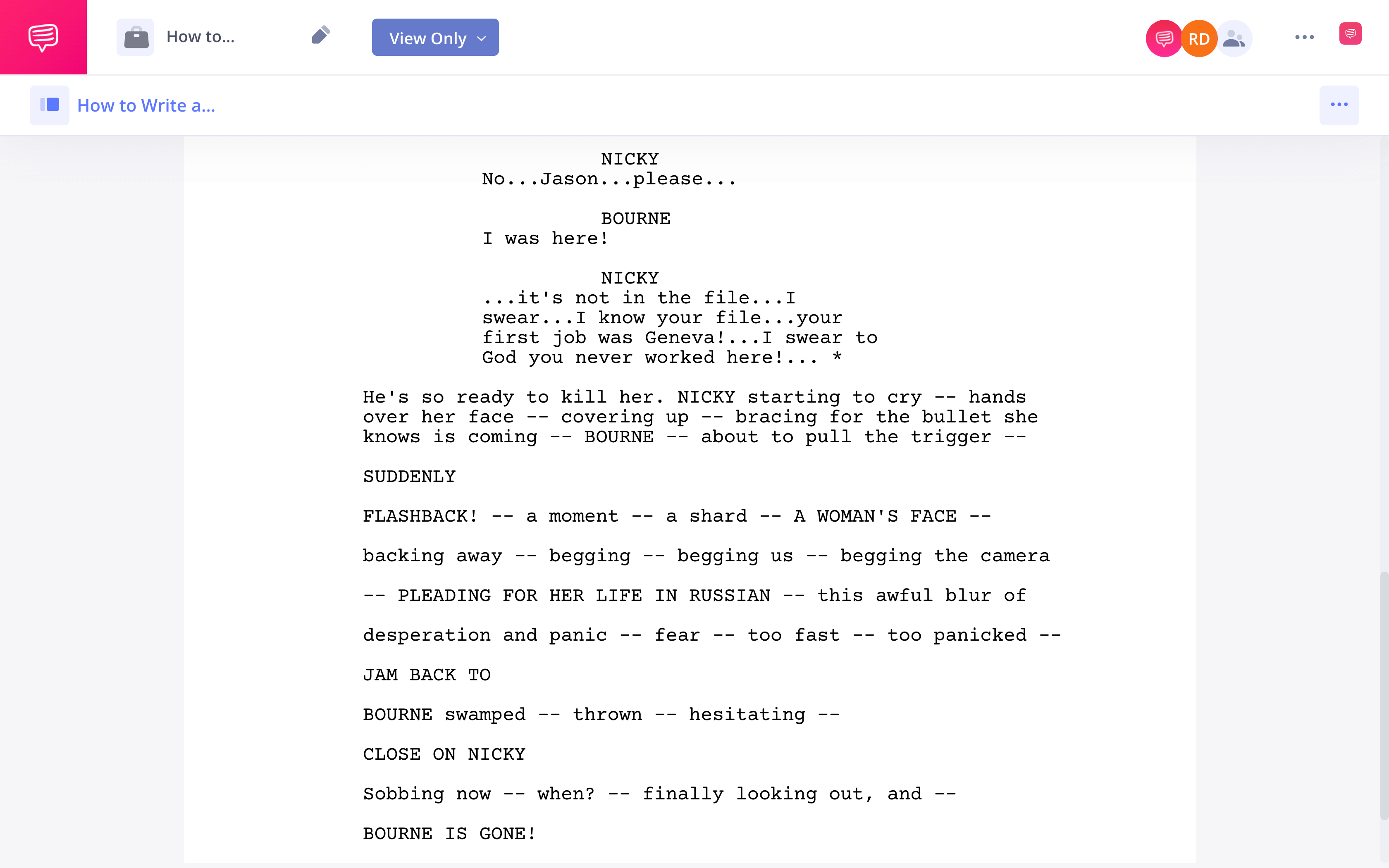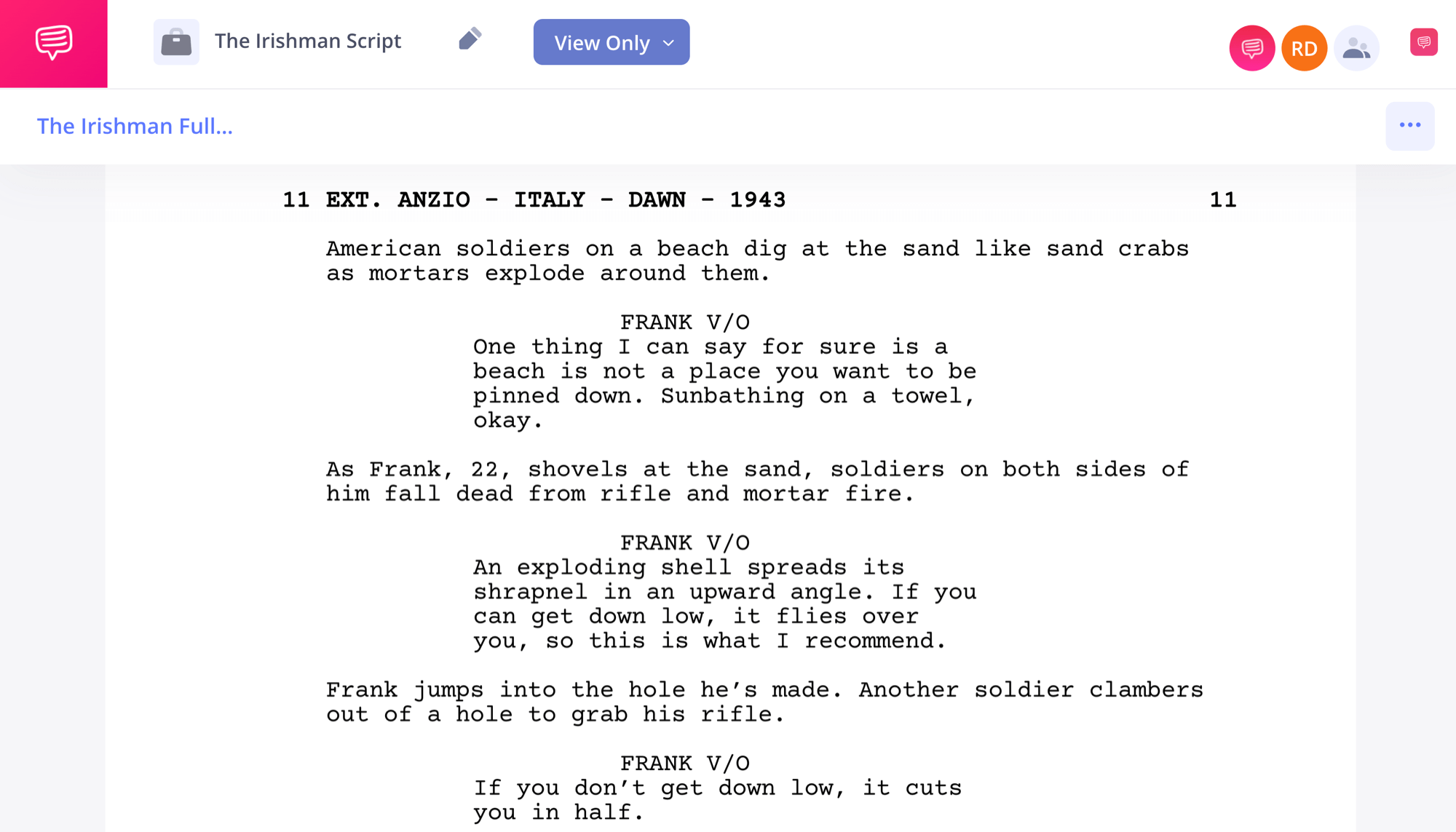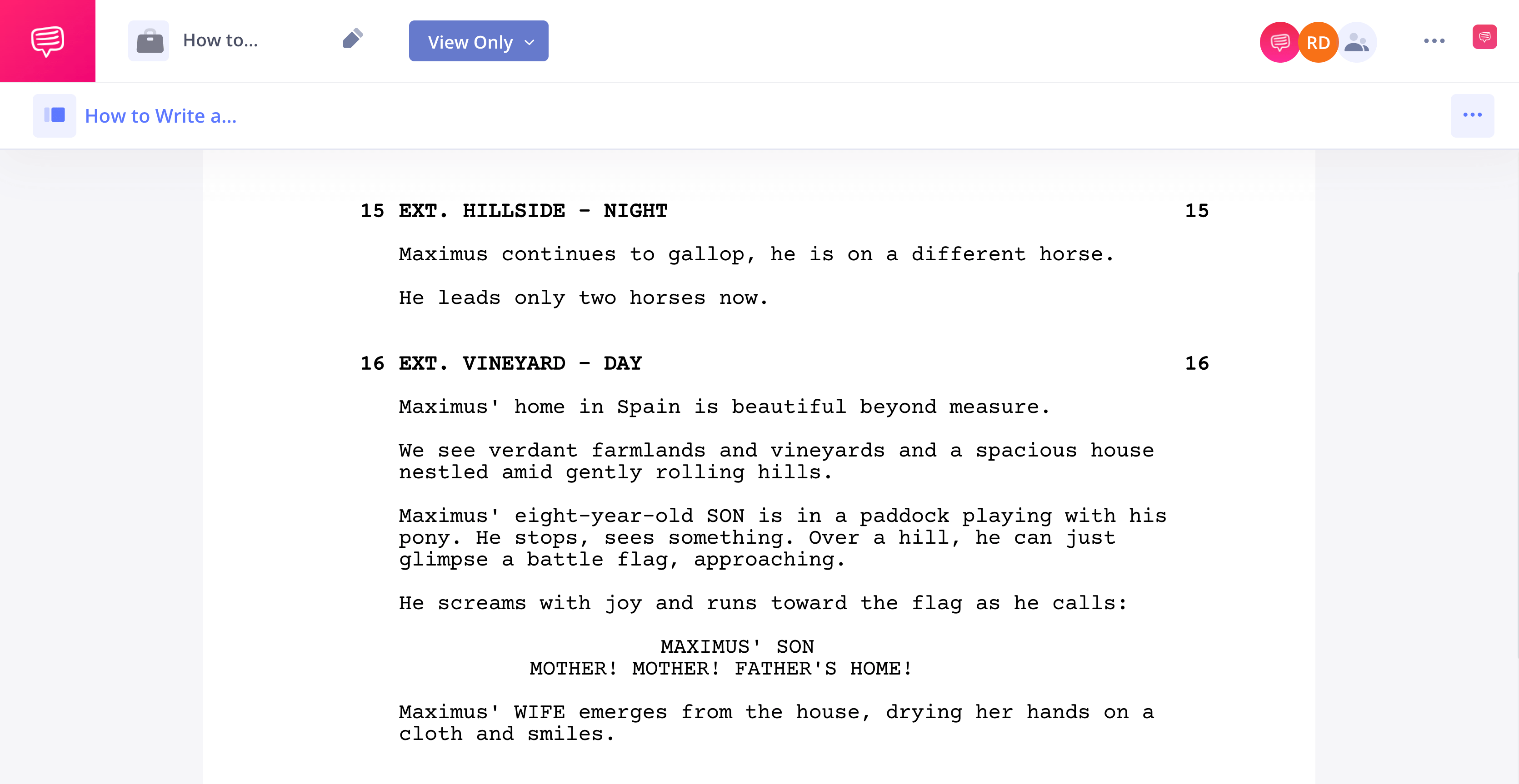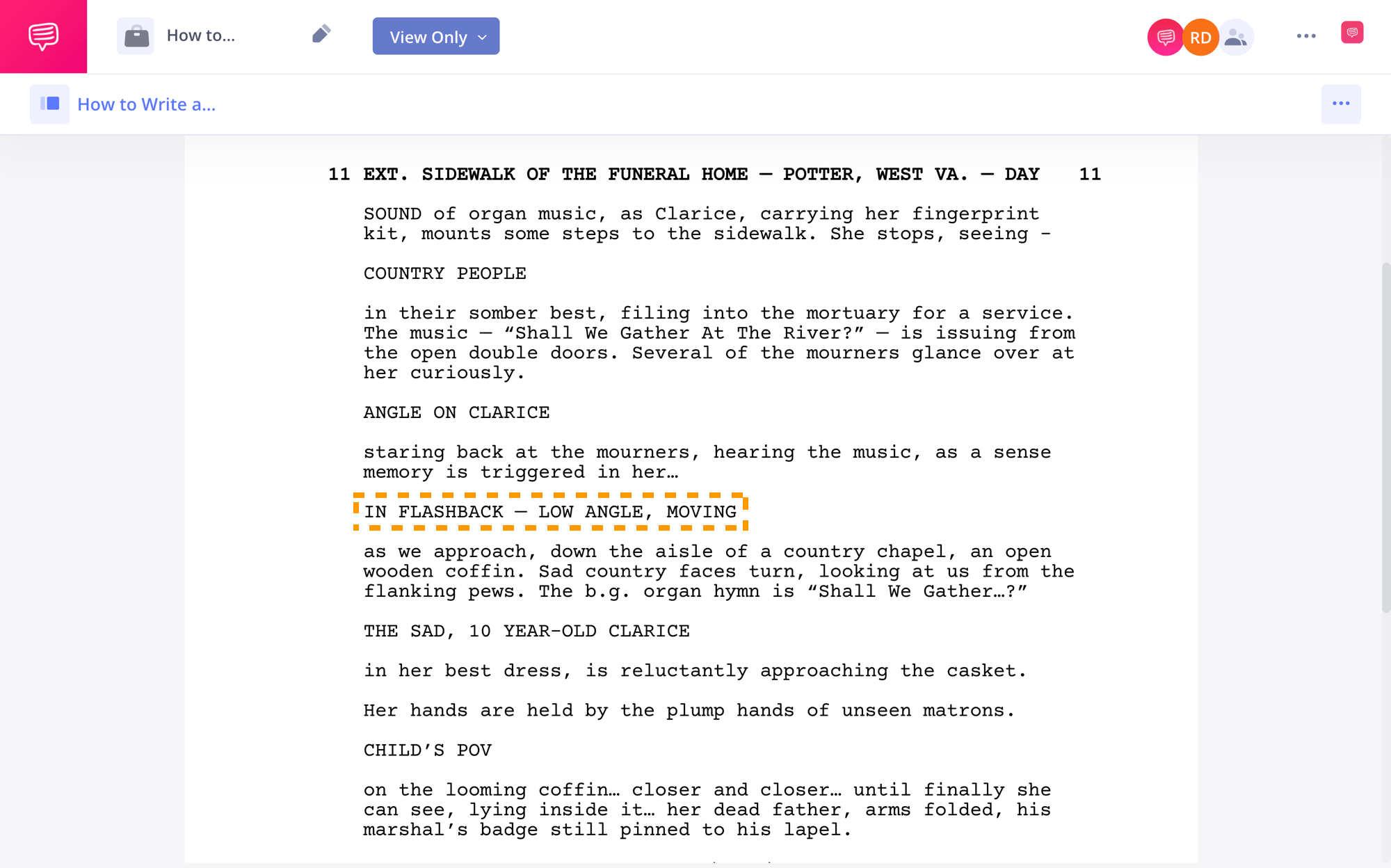Screenwriting books and instructors often warn aspiring writers against writing flashbacks in their scripts. They know that beginning and amateur writers often use them in a way that can bring a film to a dead stop. However, so many great films have used flashbacks with resounding success. So, let’s learn from some films that figured out how to write a flashback in a script the right way.
Watch: How to Write a Flashback
Flashbacks Done Right
Why flashbacks matter
Let's take a step back before we get into the technical format. What makes a flashback worth including in the first place? The best flashbacks don’t just fill in backstory—they transform the meaning of what we’re watching in the present. They reveal emotional depth, create contrast, or deliver a turning point. To do that effectively, you have to start with a clear understanding of what a flashback really is.
FLASHBACK DEFINITION
What is a Flashback?
A flashback is a scene or moment in a narrative that interrupts the chronology of a story by showing an action or event that happened earlier in the story. An internal flashback takes place within the primary timespan of the story, which aligns with the flashback literary definition, distinguishing between internal and external memory sequences. An external flashback takes place outside of its primary timeline.
Tips on How to Write a Flashback in a Script:
- Is the flashback necessary? Why?
- Consider the ideal placement of the flashback
- Weave the flashback(s) in naturally to avoid disrupting the flow of the narrative
Flashback Examples in Movies
Learn from flashback examples
Many times, when a screenplay takes a trip to the past, it is an isolated deviation. In other words, flashback scenes in movies are more common than "flashback movies." That being said, there have been several fantastic screenplays that use a flashback structure to weave in and out of a story's chronology.
Below are just a few classic flashback examples; each flashback is a scene with its own purpose and personality. Some simply start in the present and tell the entire story through one giant flashback— a bold method of writing a flashback as the film’s core structure. Others bounce back and forth strategically to tell a more nuanced narrative.
- Shawshank Redemption
- It’s a Wonderful Life
- Social Network
- Sunset Boulevard
- Hiroshima Mon Amour
- Eternal Sunshine of the Spotless Mind
- Fried Green Tomatoes
- The Godfather II
- Don’t Look Now
- Fight Club
- Citizen Kane
At the end of this article, we cover how to format a flashback in your screenplay, including scene headings, transitions, and other stylistic options. This includes how to properly structure a scene heading that introduces or exits a flashback.
But as we go along, our examples will help you adapt a style of your own. You can take some creative liberties if you honor the maxim: “Thou shalt not confuse the audience.”
Why Do Writers Use Flashbacks
The power and purpose of flashbacks
A good flashback can create suspense, raise the stakes, and clarify meaning and significance, which is exactly why flashbacks in writing remain a timeless literary technique.
A bad one slows the story momentum with boring information, or worse case, makes it feel like it’s moving backward. To determine if a flashback is necessary, ask this ironic question: Could this moment be better conveyed through flashback?
Is this flashback the best way to move the story forward?
Individually, flashbacks can deepen our connection with a character. They can clarify and accentuate a fact or feeling. When using multiple flashbacks, devise an overall strategy that lets them be more than the sum of their parts.
Will they focus on merely mystery, plot, and story? Will they deepen insight into the protagonist? Will they make us ponder meaning? We will show you when, why, where, and how to write a flashback in a screenplay to enhance emotion, structure, and theme.
Related Posts
How to Write a Flashback in a Screenplay
How to orient the audience
You are familiar with the common transitions that lead us in and out of a flashback, which include editing transitions like dissolves, clever wipes, blur effects, white flashes, leading dialogue, and ominous music.
Flashback Parody in Wayne's World
You want to avoid overused clichés yet understand their essential function. Intrigue the reader, don’t confuse them. Make sure flashbacks aren’t disorienting or distracting. Modern moviegoers have developed a sophisticated understanding of film language, so they don’t need much.
In Momento, one of Christopher Nolan's best movies, alternating color and black-and-white film stock, differentiates the present (forward-moving) and past (backward-moving) timelines.
The style of The Bourne Supremacy announces its flashbacks with a sudden surge in its rhythm, pace, and prose style. Take a close look at this example to see what we mean:
Flashback Example in The Bourne Supremacy • Read Full Scene
Flashback Examples with Recurring Props and Places
Anchor your flashbacks
The charming 1967 Stanley Donen film Two for the Road used the couple’s four distinctive cars to track them throughout the story’s four time periods.
The Irishman also uses a car like a timestamp during the 1975-set road trip, where Russell and Frank drive to Florida with their wives. It’s one of the more subtle flashback examples in modern cinema. What allows the film and this sequence to deftly slip between several eras? Not the high-tech digital de-aging process. But rather good old-fashioned low-tech ingenuity from director Martin Scorsese and his Oscar-winning editor, Thelma Schoonmaker. This is a strong reminder that writing flashbacks effectively doesn’t require fancy tools, just sharp storytelling instincts.
In this movie, Scorsese uses elements unique to each era that help to identify it:
1943 - Anzio. Frank in the war. Voiceover segue, uniform, rifle, soldiers
1950s - When Russell and Frank begin their relationship. Formal attire and manners, lush restaurant interiors, noticeable absence of wives when the men are together, music, Frank’s voiceover about Russell
1975 - Road trip to the wedding. The car, the presence of wives, Carrie’s cigarette and smoking, Frank’s voiceover about Carrie as mob royalty, sunny daylight exteriors in nature.
Flashback Example in The Bourne Supremacy • Read Full Scene
The Irishman script doesn’t even use the word “flashback.” It’s a masterclass in flashback writing, where every shift between past and present feels like a seamless part of the narrative. That should also be the goal for your flashbacks.
Build Characters and your Theme
Flashbacks beyond story & into theme
In Arrival, one of Denis Villeneuve's best movies, flashbacks and flash-forwards define the story. Amy Adams’ character Louise’s prescient powers motivate the twisty flashback structure and empower her to “save the day” and the world in the climax.
This is a moving approach to writing a flashback that intertwines memory and theme. The non-linear structure also contributes to fascinating thematic ideas about time, language, communication, and fate, evoking the feeling of time travel through memory. This is how powerful flashbacks in writing can be when used to support deeper meaning.
Theme in Flashbacks
Citizen Kane and Rashomon Effect
These two cinematic masterpieces use flashbacks in their stories in similar but ultimately different ways. The contrasting approach yields drastically different results. These examples show how flashbacks in writing can serve as a dynamic tool to manipulate narrative and reveal emotional truth.
Citizen Kane and Rashomon are renowned as masterpieces of writing a flashback that reveals subjectivity, contradiction, and theme. Their characters are unreliable narrators who contradict themselves and others due to intentional deception or subconscious subjectivity.
Everyone seems to discuss them, so to explore them more deeply, check out the clip above. But for a change of pace, here’s a flashback from Citizen Kane that is only verbal.
Citizen Kane • Verbal Flashback
Bernstein’s memory begins as intriguing, but ultimately, its anticlimactic, “shaggy dog story” ending sheds no light on the meaning of “Rosebud.” Instead, it addresses a thematic question at the heart of the film: Does subjectivity make memory unreliable?
Related Posts
Example of Flashback to Show the Unshowable
What’s love got to do with it?
Flashbacks also allow us to show what can’t be shown in any other way in the narrative. For example, in Gladiator, Maximus’s wife and son are dead. To help the audience feel his love and loss for what would otherwise be absent characters, the film shows “flashbacks” of “imagined memories” (triggered by the figurines of his wife and son).
Screenwriting software is essential to getting proper formatting for your screenplay. Here are those iconic pages from Gladiator to show you what we mean.
Flashback Example in The Gladiator • Read Full Scene
Remember how Casablanca, possibly the greatest romantic movie of all time, used a flashback similarly to show the unshowable.
In present-day Casablanca, Rick and Ilsa have lost the love they had in Paris. To rekindle that connection, the film uses a powerful example of flashback to their time together. To establish their past and draw the audience into the story, the filmmakers have to leave the present and revisit the past as Rick reminisces about their time in Paris. Check out this clip to see what we mean:
Casablanca • Paris Flashback
Ironically, the story here must go back so it can ... wait for it ... move forward.
Placement Tips with Flashback Examples
Where to put flashbacks
The placement and purpose of a flashback are inextricably related. When looking for the right spot, don’t think in terms of facts and information. Instead, look for emotion, experience, and mindset. Let a flashback align the audience, then make the return to the present feel emotionally earned and grounded in perspective, with the character’s feelings. That’s the foundation of strong flashback writing.
Destroyer is a clever and complex flashback film directed by Karyn Kusama and starring Nicole Kidman as Bell, a self-destructive cop on the hunt for a criminal for shady reasons. So you can watch or study it as a case study of how to write a flashback in a script. Here is a purposely vague and spoiler-free example from the screenplay.
Pay attention to when Bell finally finds her target, he’s wearing a mask and preparing to rob a bank.

Flashback Scene in Destroyer
She needs to know it’s him. And we need to know it’s him. More importantly, we need to know she knows it’s him. We can then “feel” her processing the emotional revelation, which motivates her to abruptly drop her cover and risk her life to pursue him.
Here is another typical placement of a flashback, but it’s a bit more subtle. In one of the best crime movies out there, The Silence of the Lambs, Clarice travels to West Virginia for an autopsy of one of Buffalo Bill’s victims. The exam room happens to be in the back of a funeral home. An unrelated funeral triggers a flashback to her father’s funeral:
Flashback Scene in Silence of the Lambs • Read Full Scene
This flashback is precisely placed, but its function is less obvious and concise than our Destroyer example. It gently creates emotional resonance by relating the case and Clarice’s career to her father. She has no personal relationship to the funeral, so the flashback is necessary to explore these feelings.
Creating Impact with the Right Flashback Example
Create maximum impact
This scene in the final act of Girl on the Train works on many levels and has perfect placement. We get to experience her life-changing epiphanies in the moment as she is having them — an example of flashback perfectly synced with character insight.
Girl on the Train Ending Scene
If the flashbacks come before or after this point, we feel like detached observers. Because they mirror her internal process and epiphanies, we experience them as empathy and catharsis, even more so than if the events had unfolded in real time. They align the audience with the character, a crucial goal of great flashback writing in emotional storytelling.
A flashback that is well-placed and visually integrated can unify or accentuate story, character, and theme, making it one of the most powerful tools in a writer’s toolkit.
Related Posts
UP NEXT
How to write a montage
Now that we’ve covered how to write a flashback in a script, you may have noticed that many of these scenes and sequences are also montages. While there are some similarities between "how to write a flashback in a screenplay" and "how to write a montage," there are a few key differences you should know. In this follow-up post, we'll dive into the formatting and techniques used by professional screenwriters when crafting a montage.
